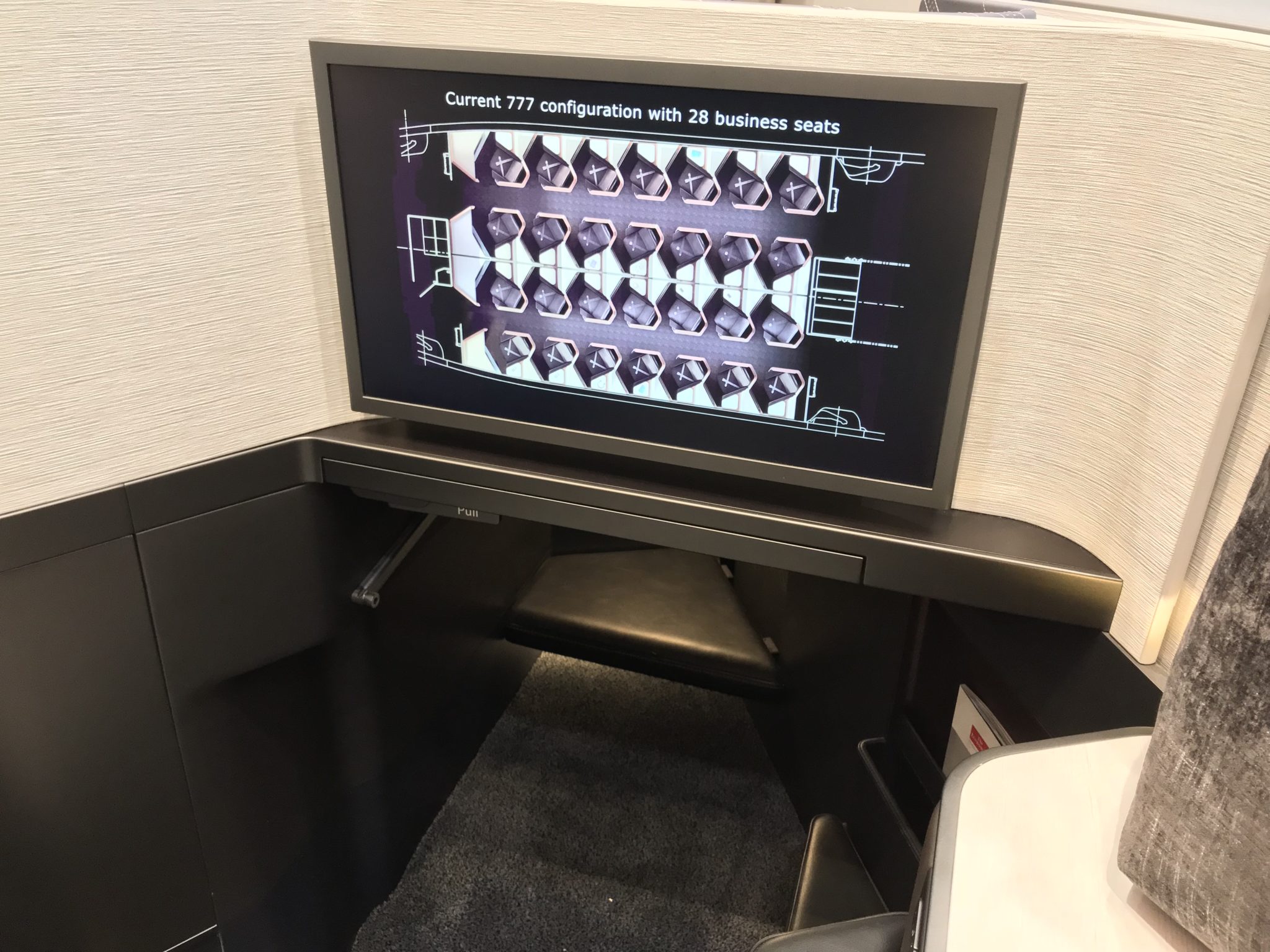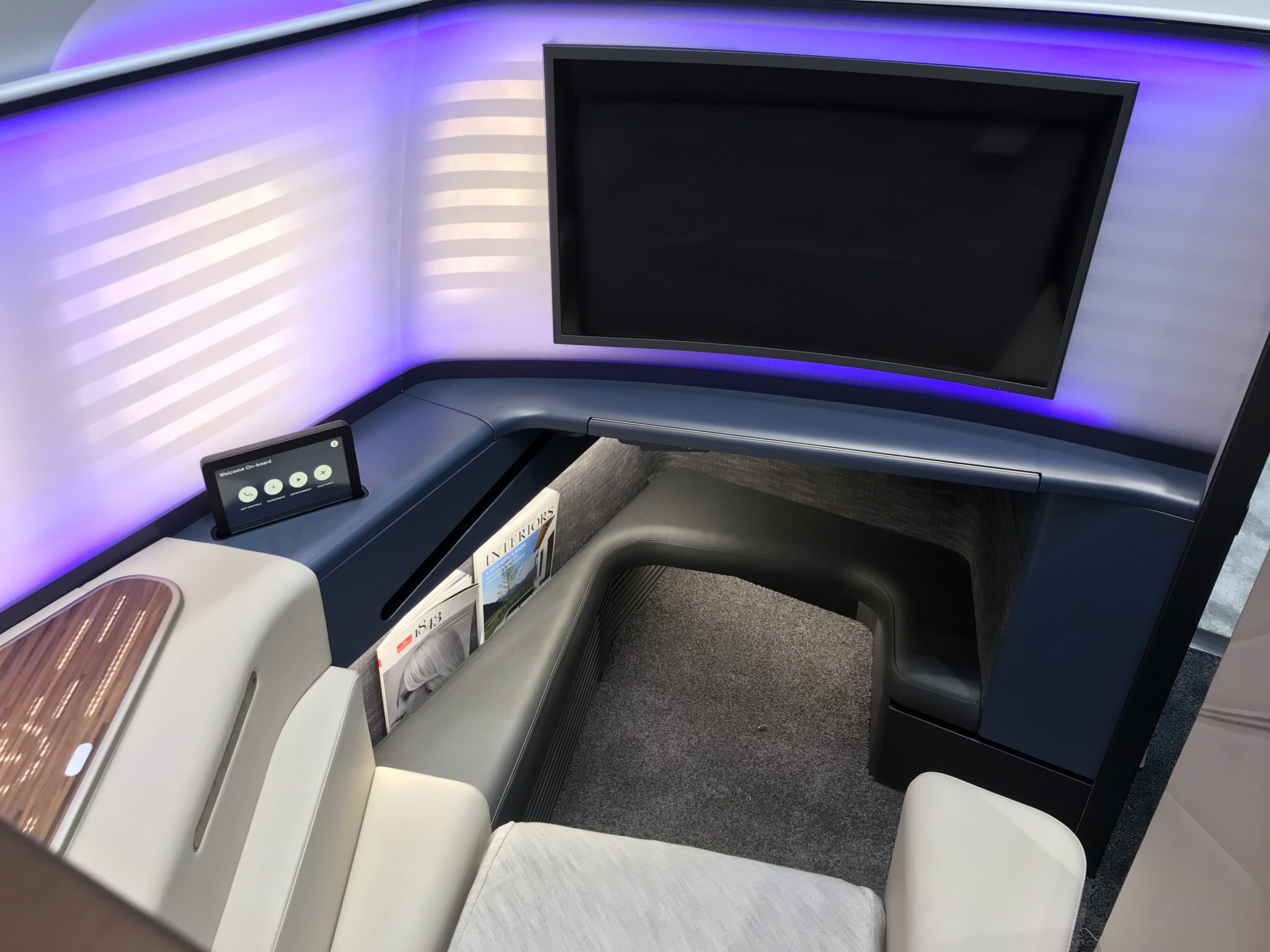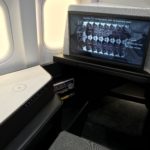First class is dead; long live first class. This apparent contradiction is at the heart of a particularly fascinating niche in the airline passenger experience: how can airlines continue to offer a super-premium product for their very best (and spendiest) customers without investing time and money in extra onboard space, an entirely separate cabin or a completely different seating product?
One set of answers from Rockwell Collins is an evolution of the wildly popular outward-facing herringbone Super Diamond product.
The next generation of the evolved seating product, which Rockwell Collins vice president for sales and marketing Mark Vaughan showed off to Runway Girl Network at this year’s Aircraft Interiors Expo, is called Elements, and brings both a new aesthetic, a new premium market — and of course the near-obligatory option for doors — to the Super Diamond family.
The basic premise is to create a front row hard product option for first class, whether separated by cabin dividers or suite doors, without losing any space from the footprint of the business class cabin.
Inside these business-plus, first-minus seats sit upgraded materials, a good bit of extra space, larger inflight entertainment screens, more stowage, and the opportunity to create additional soft product provisions.

Adding a front row first-minus or business-plus product doesn’t affect the footprint of the rest of the cabin. Image: John Walton
Thinking about the visual cues Rockwell Collins is giving to the industry, the Elements front row seat sections both feature a set of warming, palettes showing off a variety of greys, browns, beiges and creams, as well as a bamboo-style inlay on one of the sets. Wireless charging is clearly marked, and is just as clearly a trend that airlines are getting behind.
You might note the curved business class monitors in the purple-moodlit front row seat. This, Rockwell’s Mark Vaughan says, is to press the inflight entertainment side of the industry to get thinking properly about how it plans to integrate larger, curved, home entertainment system type monitors that are common in domestic settings but have yet to make their mark on the inflight entertainment world.
Three key enablers create a context in which Rockwell can offer these new first-minus, business-plus cabins for Elements.
The first is that the bulkhead seat in most herringbone layouts is already advantageous thanks to the lack of passenger in front. (That’s also the case in a number of staggered seats, as seen in Malaysia Airlines’ implementation of the Thompson Vantage XL seat in its Airbus A350 first class product.) This means in some instances more legroom, and in quite a few cases a set of airline booking logic that preserves these seats for the highest-status frequent flyers for as long as possible, usually until the flight is released to airport control.
The second enabler is the explosive growth of suite doors in the business class market. Whereas in previous years it would have been a trifle awkward for business class passengers to be watching the first class section of the cabin being served better Champagne, different meals, and so on, if everyone has their own set of doors then there’s a lot less looking.
And the third is the realisation on the part of airlines, seatmakers and product designers that it is increasingly hard to offer a first class product on anything but a flagship aircraft: as an example, take Korean Air’s latest first class product, the Rockwell Collins Apex seat that it also uses in business, although it oddly interrupts the stagger that is part of the compelling reason to take these seats.
Despite recent flagship products, it’s hard to escape the feeling that we’re nearing the end of the performance for first class as we know it. These new products may allow it one final swan song before business class, waiting in the wings, becomes the PaxEx headliner.

Airlines can offer the front row seats for first class passengers — or indeed as an upgrade for increasingly valuable business class frequent flyers. Image: John Walton
Image Gallery:
- The lack of any seat in front means more space can be given over to the front row. Image: John Walton
- Smart seatmakers are thinking about how to make money during the long twilight of first class. Image: John Walton
- New storage and soft product options are unlocked with the extra space in the front row. Image: John Walton
- The Elements update to Super Diamond is itself impressive — even in business. Image: John Walton
Related Articles:
- Flexible displays could be part of future travel experience
- If you liked it, then you (should) have put a door on it
- Winning the zero-sum game with storage and features, not angles, doors
- Astronics reveals dock style wireless charging in tray table
- $500 for a door? Delta starts charging for better biz PaxEx
- Behind the customisation and certification cleverness of Rockwell MiQ
- Korean Air picks same B/E Apex seat for 787-9 business and first
- New Formation “super-throne” posits business/first questions
- Three-abreast widebody Super Diamond offers next-gen business option
















